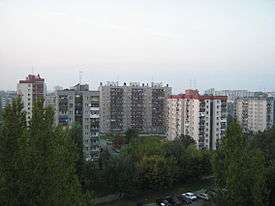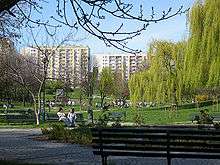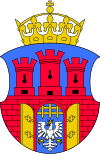Nowa Huta
| Nowa Huta | |
|---|---|
|
Bird's eye view. | |
|
Nowa Huta (№ XVIII) on the map of the 18 districts of Kraków, with Vistula River running from west to east. | |
| District expansions (until 1990) | |
| |
Nowa Huta (pronounced [ˈnɔva ˈxuta], literally The New Steel Mill) - is the easternmost district of Kraków, Poland, (District XVIII, see map). With more than 200,000 inhabitants, it is one of the most populous areas of the city. Neighboring districts until 1990 considered expansions of the original Nowa Huta township, and linked by the same tramway system, include Czyżyny (XIV), Mistrzejowice (XV), Bieńczyce (XVI), and Wzgórza Krzesławickie (XVII, known as Grębałów until 2006). They are now separate districts of Kraków.
History
The historic area of present-day Nowa Huta is one of the few places in Poland settled continuously since the neolithic age. Archeological research has discovered a big Celtic settlement and Poland's oldest Slavic settlements there. In the 8th century, a mound was erected nearby by the Vistulans. According to legend, the Wanda Mound is a tomb of Wanda, daughter of Krakus, a mythical founder of Kraków (Cracow). In the 13th century a Cistercian monastery in the village of Mogiła was built.[1][2]
In the 19th century and in the beginning of the 20th century, during the partitions of Poland and up to the First World War, the outskirts of Nowa Huta constituted a border between territories controlled by the Austrian and Russian empires. One can find historic Austro-Hungarian forts there, and one of Europe's oldest permanent airfields (Kraków-Rakowice-Czyżyny Airport, currently housing the Polish Aviation Museum).
Following the Vistula-Oder Offensive in 1945, the Communist authorities had encountered substantial resistance to their new regime from middle-class Cracovians. A referendum held by the authorities was soundly defeated by the people of Kraków - a major cause of embarrassment for the government. To "correct the class imbalance", the authorities commenced building a satellite industrial town to attract people from lower socioeconomic backgrounds to the region, such as peasants and the working class.[1]
Nowa Huta was started in 1949 as a separate town near Kraków on terrain taken by the Communist government from former villages of Mogiła, Pleszów and Krzesławice. It was planned as a huge centre of heavy industry. The town was to become an ideal town for the Communist propaganda and populated mostly by industrial workers. In 1951 it was joined with Kraków as its new district and in the following year tramway communication was started.[1]

On July 22, 1954, the Vladimir Lenin Steelworks was opened and in less than 20 years the factory became the biggest steel mill in Poland. In the 1960s the city grew rapidly. The monumental architecture of the Central Square (Plac Centralny) was surrounded by huge blocks of flats. In the 1970s the steel production reached 7 million tons annually. At the same time the biggest tobacco factory in Poland was opened there and a huge cement factory.
The reasons for building such an industrial town near Kraków were mostly ideological because coal had to be transported from Silesia and iron ore from the Soviet Union; while the products were shipped to other parts of Poland due to local demand for steel being relatively small. Such disadvantages became visible in the 1980s, when the economic crisis halted the city's growth. Nevertheless, the primacy of political reasons for choosing this location is not obvious. Kraków was a centre of learning, with established schools of engineering and scientific research departments, providing the necessary expertise along with qualified staff. The presence of good rail links for bringing raw materials and the proximity of the river to supply water also played a role. The site was elevated enough to avoid flooding, and the historic villages razed, were relatively small. All above factors quickly made the investment pay off.[3][4]
One type of building lacking from the original urban design of Nowa Huta township was a Roman Catholic church. The public campaign to construct it lasted several years. As early as 1960, inhabitants of Nowa Huta began applying for permit to build a church. In that year, violent street fights with riot-police erupted over a wooden cross, erected without a permit. The locals were supported by Bishop Karol Wojtyla, the future Pope John Paul II, who started holding outdoor Christmas Eve Midnight Masses in 1959, regardless of weather, and replaced the cross every time it was removed. In 1967, permits to build the desired church were granted and eventually a church called the Lord's Ark was built. The complex was consecrated by Wojtyla in 1977.[5] Wojtyla himself, after being elected Pope in 1978, wanted to visit Nowa Huta during his first papal pilgrimage in 1979, but was not permitted to do so.
In the 1980s Nowa Huta became a place of many demonstrations and violent street protests of the Solidarity movement, fought by the police. At that time, almost 29,000 of the 38,000 workers of the then Lenin Steelworks belonged to the Solidarity trade union.[6]
Architecture
Before 1956 (Socialist Realism)


The doctrine of socialist realism in Poland, as in other countries of the People's Republics, was enforced from 1949 to 1956. It involved all domains of art, but its most spectacular achievements were made in the field of architecture. The main lines of this new trend were very precisely indicated in a 1949 resolution of the National Council of Party Architects. Architecture was an extremely important weapon to the creators of a new social order. It was intended to help to form a socialist theme - the ideas sparking citizens' consciousness and outlook on life. During this great work, a crucial role fell to the architect, who wasn't perceived as merely an engineer creating streets and edifices, but an "engineer of the human soul". The general outlook of a building was more valued than its simple aesthetics. It needed to express social ideas, to arouse a feeling of persistence and power.
Since the style of the Renaissance was generally regarded as the most revered in old Polish architecture, it was to become also Poland's socialist national format. However, in the course of incorporating the principles of socialist realism, there were quite a few deviations introduced. One of these was to more closely reflect Soviet architecture, which resulted in the majority of works blending into one another; and finally the general acceptance of the classicist form. From 1953, critical opinions were increasingly frequently heard, and the doctrine was finally given up in 1956. Currently the socrealist city centre is considered a monument of architecture.
After 1956


Following the political liberalization of the Polish October in 1956 it became possible to introduce modernist style in architecture. Polish architects were allowed to visit Stockholm to learn about the newest solutions in urban design. As a result, the so-called "Swedish" apartment block was developed according to Le Corbusier guidelines. Among other buildings from that era, the Światowid cinema is worth noting. In the 1980s the first postmodernist buildings were built (Centrum E housing estate). In the 1970s and 1980s most blocks of flats were built using plattenbau.
Nowa Huta's central Avenue of Roses featured a countrywide known statue of Vladimir Lenin unveiled on April 28, 1973. The bronze monument was pulled down in 1989 by the city, as a result of numerous protest actions by local citizens. Several thousand onlookers came to watch the dismantling.[8]
Also sacral architecture should be noted, especially Arka Pana (Lord's Ark) church, which was built to resemble Noah's Ark. It was designed by the architects Wojciech Pietrzyk and Jan Grabacki, with the design being influenced by Le Corbusier's Notre Dame du Haut in Ronchamp.[9]
Nowa Huta today

Since the fall of Communism the city that was once a showpiece for Stalinism now boasts many tributes to ardent anti-Communists. Streets formerly named after Lenin and the Cuban Revolution have been renamed to honor Pope John Paul II and the Polish World War II hero Władysław Anders. Other streets were renamed after Edward Rydz-Śmigły and Ignacy Mościcki, politicians of the prewar Sanation regime. In 2004, Plac Centralny, Nowa Huta's central square which once was home to a giant statue of Lenin - on display at the High Chaparral Museum in Hillerstorp, Sweden, was renamed Ronald Reagan Central Square (Plac Centralny im. Ronalda Reagana) in honour of the former U.S. President.[11][12] However, this decision led to many objections,[13][14] and the traditional name is still widely used.
Cultural significance
Nowa Huta is the location of an award-winning film by Andrzej Wajda called the Man of Marble (Polish: Człowiek z marmuru), based on a true story of the rise and fall of a Stakhanovite bricklayer who helped build the new model socialist city in the course of Stalinism in Poland. Man of Marble, made in the mid 1970s, presaged the Solidarity labor union movement in Gdańsk that was ultimately responsible for overthrowing Communism, as the film that starts in Nowa Huta ends in Gdańsk.
When the district was built in the 1950s, songs promoted by propaganda in the People's Republic of Poland included the widely popular hit single "O Nowej to Hucie piosenka" (This Song is about Nowa Huta),[15] still remembered today especially by many Poles of the older generation.
Nowa Huta has figured prominently in Polish literature since its very beginning. The earliest works focused on ideological progress and on the conflict between the bourgeois city (Kraków) and its new Communist district of Nowa Huta (a Party bastion). Among writers were Marian Brandys (Początek opowieści, 1951) and Tadeusz Konwicki (Przy budowie, 1950). A hefty supply of short poems included Jalu Kurek's "Z nowej Huty pocztówka" (1953; a city park (pl) was named after him for that) and future Nobel laureate Wisława Szymborska ("Na powitanie budowy socjalistycznego miasta", 1952; from the collection of Stalinist paeans of praise called Dlatego żyjemy).[16] Although Nowa Huta disappeared from literary narratives after the period of Socialist realism, it returned during the 1980s when it became the hotbed of struggle against Communism and later, during the 1990s, when it became a symbol of the new post-Communist reality stemming from both its socialist and anti-socialist past.[3][17]
Poland's first-ever opera written in 1794 by Wojciech Bogusławski, called The Presumed Miracle, or the Cracovians and the Highlanders (Polish: Cud mniemany, czyli Krakowiacy i Górale),[18] is set in the historic village of Mogiła where Nowa Huta was built. The two newest housing estates are named after the play: osiedle Krakowiaków (the Cracovians Estate) and osiedle Górali (the Highlanders Estate). The opera by Bogusławski was also the first theatre production played upon the opening the district's legendary Ludowy Theatre.[19]
Oedipus - a tragedy from Nowa Huta is a play based on ancient Greek myth about Oedipus, premiered in Łaźnia Nowa Theatre under direction of Bartosz Szydłowski[20]
Cultural venues
_Krakow.jpg)
- Teatr Ludowy (The People's Theatre), Nowa Huta's original theatre venue.[21][22]
- Łaźnia Nowa Theatre[23]
- Sfinks art-house cinema[24]
- The Nowa Huta Cultural Centre[25]
- The Cyprian Norwid Cultural Centre[26]
Landmarks

- Wanda Mound (Polish: Kopiec Wandy), (8th century)
- Cistercian abbey in Mogiła (1225)
- Jan Matejko manor in Krzesławice
- Branice manor
- St. Wenceslaus Church (1226)
- St. Bartholomew Church (1466)
- Austro-Hungarian forts: Batowice, Mistrzejowice, Dłubnia, Krzesławice, Grębałów, Mogiła
- Tadeusz Sendzimir Steel Mill (formerly Vladimir Lenin Steel Works)
- Plac Centralny, and Aleja Róż (Avenue of Roses) architecture
- Arka Pana (Lord's Ark) church and Chapel of Conciliation in Bieńczyce
- Polish Aviation Museum in Czyżyny
- Branch of the Historical Museum of Kraków, History of Nowa Huta[27]
Industry
- Tadeusz Sendzimir Steel Mill (Polish: Huta im. Tadeusza Sendzimira) owned by Mittal Steel Company
- Kraków Power Station (Polish: Elektrociepłownia Kraków)
- Philip Morris Cigarettes Co.
- ComArch, an international software house
- INTERIA.PL, a company operating Poland's third biggest portal
Education
- Faculty of Mechanical Engineering, Tadeusz Kościuszko University of Technology.
- Academy of Physical Education (AWF)
Sport
Nowa Huta is home to several notable Kraków sports clubs. Rich in history Hutnik Nowa Huta football club has a sizeable support in the city, as does Kraków's only speedway club Wanda Kraków.
See also
Notes and references
- 1 2 3 Jerzy Aleksander Karnasiewicz, Nowa Huta. Okruchy życia i meandry historii (English: Nowa Huta. Crumbs of Life and the Meanders of History), photo anthology; Wydawnictwo Towarzystwo Slowaków w Polsce, Kraków, 2003; ISBN 83-89186-67-5
- ↑ Cistercian monastery in Mogiła webpage
- 1 2 Prof. Alison Stenning (2002), "Living In The Spaces Of (Post-)Socialism: The Case Of Nowa Huta" (PDF file, Wayback direct download), School of Geography, Earth and Environmental Sciences, University of Birmingham.
- ↑ Jamie Stokes (February 25, 2011), Nowa Huta: Krakow’s Brutal Brother? Krakow Post: News, Events, Lifestyle.
- ↑ History of Nowa Huta, Gates of Lesser Poland informational portal
- ↑ Nowa Huta, "Ciekawe miejsca" at www.60nh.pl
- ↑ Szkolne housing estate in Nowa Huta at Fotodokumentacja NH 2011.
- ↑ UPHEAVAL IN THE EAST; Lenin Statue in Mothballs, The New York Times, December 11, 1989. Retrieved June 9, 2013.
- ↑ Sacred buildings: a design manual By Rudolf Stegers, page 120, ISBN 978-3-7643-6683-4
- ↑ Park Tysiąclecia in Nowa Huta at Fotodokumentacja NH 2011.
- ↑ "A Day Out in Lenin Land" at Cracow-life.com
- ↑ Related story at www.expatica.com
- ↑ Related story at www.nowahuta.org.pl
- ↑ Related story at www.zyciekrakowa.pl
- ↑ "O Nowej to Hucie piosenka" featured here with the YouTube video.
- ↑ "Buble i inne rupiecie (Schlock and other antiques)". Polityka, poezja (in Polish). Unicorn. Retrieved March 26, 2013.
- ↑ Katarzyna Zechenter, 'Evolving Narratives in Post-War Polish Literature: The Case of Nowa Huta (1950-2005)', The Slavonic and East European Review, Vol. 85, No. 4 (Oct., 2007), p. 683. An extract archived from the original on March 25, 2013. Retrieved March 25, 2013.
- ↑ Wojciech Bogusławski at Culture.pl webpage of the Adam Mickiewicz Institute, Poland.
- ↑ The Ludowy Theatre at www.krakow.pl
- ↑ Łaźnia Nowa Theatre homepage
- ↑ Related story at www.krakow.pl
- ↑ Teatr Ludowy at Cracow-life.com
- ↑ Łaźnia Nowa Theatre homepage
- ↑ Sfinks art-house cinema homepage
- ↑ Nowa Huta Cultural Centre at www.krakow.pl
- ↑ The Cyprian Norwid Cultural Centre at www.okn.edu.pl
- ↑ Nowa Huta Branch of the Historical Museum of Kraków at www.mhk.pl
Bibliography
- Mariusz Czepczyński, Cultural Landscapes of Post-Socialist Cities. Representation of Powers and Needs. Ashgate 2008. ISBN 978-0-7546-7022-3.
- Katherine Lebow, Unifinished Utopia. Nowa Huta, Stalinism and Polish Society 1949-1956. Cornell University Press 2013. ISBN 978-0-8014-5124-9
- Stanisław Panek and Edmund Piasecki. Nowa Huta. Wrocław 1971.
- K. Pozniak, "Reinventing a Model Socialist Steel Town in the Neoliberal Economy: The Case of Nowa Huta, Poland", City and Society, 1 (2013), pp. 113–134.
- Katarzyna Zechenter, "Evolving Narratives in Post-war Polish Literature: The Case of Nowa Huta (1950-2005)", Slavonic and East European Review, 85 (4) 2007, pp. 658–683. ISSN 0037-6795
- Katarzyna Zechenter, "Repositioning of Postsocialist Narratives of Nowa Huta and Dunaújváros", Revue des Études Slaves, 86 (1-2) 2015, pp. 141–156. ISSN 0080-2557
External links
- Nowa Huta Tourist Route, from the city's official website
- Nowa Huta, A Communist Paradise
- (English) (German) (Polish) Mindmapping Nowa Huta, student workshop
- (English) (German) (Polish) NH Reportage, photos
- (Polish) Nowa Huta internet portal
- Arka Pana, Catholicism Comes to Nowa Huta
- (Polish) Nowa Huta daily news
- (English) Poems by Immanuel Mifsud about Poland including two about Nowa Huta
- (Polish) Nowa Huta Fotodocumentation (architecture + interactive map)
- Satellite photo of Nowa Huta centre
- Satellite photo of the steelworks
- The Snapshots My Way (The Colors of Nowa Huta. Options: The Nowa Huta - Walks, Churches, Meadows, Parks etc.)
Coordinates: 50°04′20″N 20°02′15″E / 50.07222°N 20.03750°E


